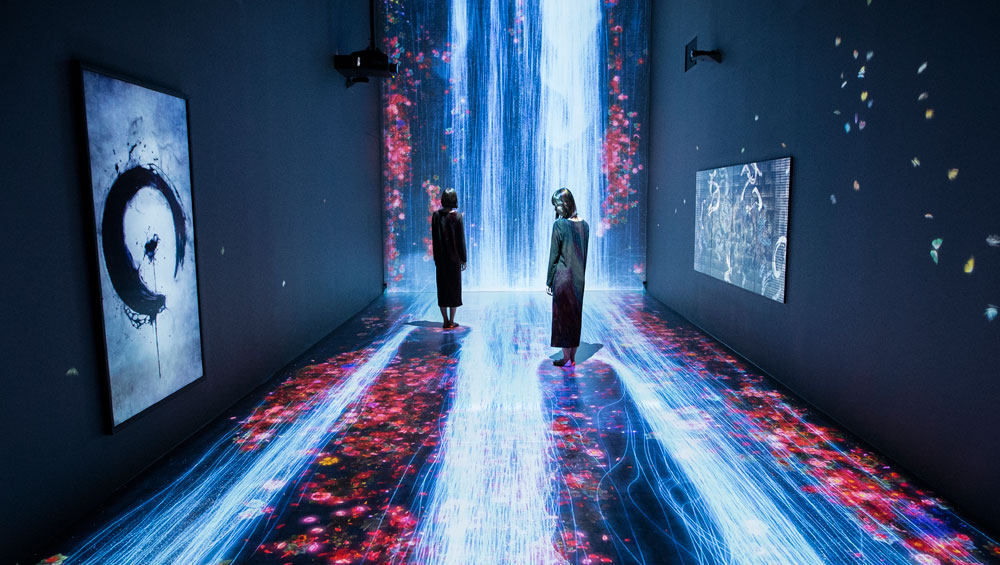
Pace Gallery, London
25 January – 11 March 2017
by EMILY SPICER
TeamLab, a collective founded in Japan in 2001, is a futuristic group seeking to exploit new technologies (and some pretty advanced computer programs) with the aim of making works as fluid and malleable as human thought processes. It counts artists, programmers, animators, architects and mathematicians in its ranks, all collaborating to create installations that morph and sparkle their way across gallery walls in time to ambient music. Other animated pieces are contained on screens like digital “paintings” but, unlike their static forebears, they move and change in virtual space.
Visitor numbers are limited and, when you arrive for your pre-booked time slot, prepare to be ushered through the first two rooms to a third, glowing space. Here, you will be handed a white cape, so that you can better see the bursting blooms that spread across your body and gather at your feet. The second room contains Dark Waves, an animated series of swells that undulate across a line of screens at a hypnotic pace. While the movement is convincing, viewed up close, each wave contains narrow streaks of light that fade like distant blue fireworks. This is the stuff of fantasy, occupying a space somewhere between simulation and imagination. It as though a magician has brought to life a print by Katsushika Hokusai.
The last room speaks to very Japanese traditions. Impermanent Life is made up of mesmerising patterns that move like entwined, swirling swathes of fabric, the robes, perhaps, of a Japanese emperor. In the background, white blossom petals open and disperse in a cycle representing life and death. The screen on the opposite wall contains an enso circle, which in Zen practice is drawn to express a moment when the mind is free to let the body create. This example has been “painted” in “ink” and then animated as a three-dimensional shape, which turns and bleeds black pigment; an effect that is simple in its conception, but no doubt complex in its execution.
But this last room is not all about looking. As with the flowers of the first gallery, the motifs in this space interact with people; humans become agents in the evolution of this digital world. Wandering blooms slowly transform into a neon waterfall, which parts at people’s feet. Butterflies materialise and dance in trails along the walls, but should you reach out to touch one, it will disappear, another allusion to mortality, but also, perhaps, to the illusory nature of the digital world. The most astounding thing about this particular display is that it is created in real time by a computer program. The interactive elements are not playing on a loop, they are not even pre-recorded, and what you see in one moment will never be repeated. It is almost as if the computer is improvising, free to create like the uninhibited Zen master.
In an exhibition where even your face becomes a canvas and the artworks react to your presence, human behaviour adds a fascinating extra layer of meaning. In that way, it bears similarities to Olafur Eliasson’s Weather Project (2003), which bathed the Turbine Hall of the Tate Modern in the otherworldly glow of an artificial sun. Although no heat was generated, visitors lay prone on the concrete floor as if they were on a beach in the Mediterranean. Which begs the question: are we all just slaves to visual cues? You might want to ask yourself that as you chase digital butterflies. But the chances are you will be too distracted by the trippy, meditative world, which can make you feel a bit as if you have been trapped in a screensaver, but will most likely make you feel as though you have stumbled on some futuristic garden of Eden.